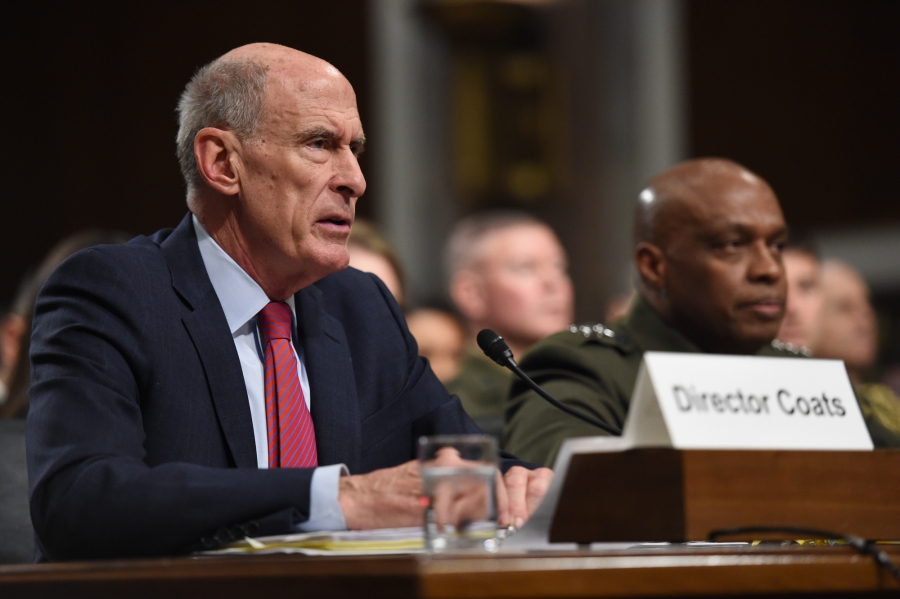Who Will Be the Acting Director of National Intelligence (DNI) on Aug. 15?
Can the president appoint whomever he wishes to serve as acting director of national intelligence (DNI) during the period between the resignation of Dan Coats (effective Aug. 15) and Senate confirmation of a successor? The president seems to think so, indicating in a tweet yesterday that “the Acting Director will be named shortly.”
....be leaving office on August 15th. I would like to thank Dan for his great service to our Country. The Acting Director will be named shortly.

Published by The Lawfare Institute
in Cooperation With

Can the president appoint whomever he wishes to serve as acting director of national intelligence (DNI) during the period between the resignation of Dan Coats (effective Aug. 15) and Senate confirmation of a successor? The president seems to think so, indicating in a tweet yesterday that “the Acting Director will be named shortly.”
....be leaving office on August 15th. I would like to thank Dan for his great service to our Country. The Acting Director will be named shortly.
— Donald J. Trump (@realDonaldTrump) July 28, 2019
The president does not have discretion in this matter, however, so long as there is a current principal deputy.
1. Doesn’t the Federal Vacancies Reform Act (FVRA) give the president considerable discretion?
It is true that the FVRA (5 U.S.C. § 3345) gives the president a fair amount of discretion to designate an “acting” agency head in the event of a vacancy, as a general proposition. Steve Vladeck has provided a handy summary of the three options it confers:
The president may choose the “first assistant” to the vacant office, choose anyone currently holding a Senate-confirmed position in the executive branch, or choose a non-Senate-confirmed senior employee who has been serving in the same agency as the vacant office for at least 90 of the previous 365 days.
If the FVRA controls, then the president has a number of options at his disposal. The critical question is: Does the FVRA control?
The FVRA itself has something to say on this subject. In relevant part, 5 U.S.C. § 3347 provides that Section 3345 is:
… the exclusive means for temporarily authorizing an acting official to perform the functions and duties of any office … unless … a statutory provision expressly … designates an officer or employee to perform the functions and duties of a specified office temporarily in an acting capacity …
In this case, there is such a statutory provision.
2. What does the 2004 Intelligence Reform and Terrorism Prevention Act (IRTPA) say about DNI vacancies?
Congress created the Office of the Director of National Intelligence (ODNI) and the position of DNI in a 2004 statute called the Intelligence Reform and Terrorism Prevention Act (IRTPA). (For an excellent history of the IRTPA’s creation, see Mike Allen’s Blinking Red.) The IRTPA included a provision addressing the question of who can serve as the acting DNI in the event of a vacancy. The provision, now codified as 50 U.S.C. § 3026(a)(6), states in relevant part:
(6) The Principal Deputy Director of National Intelligence shall act for, and exercise the powers of, the Director of National Intelligence … during a vacancy in the position of Director of National Intelligence. [Emphasis added.]
Taken literally, this would seem to override the discretion that the president otherwise would have enjoyed under the FVRA, compelling the conclusion instead that the current “principal deputy director” (Sue Gordon, a widely respected career official who has held this position since 2017) “shall” serve as the acting DNI for so long as necessary. (Matthew Whitaker presented a superficially similar situation when he was appointed as acting attorney general, but the Justice Department-specific statute in that case contains the word “may” rather than “shall.”)
3. Can the IRTPA be interpreted as simply an extra option, alongside the FVRA options?
Absolutely not.
As an initial matter, this is the best plain-text reading of the IRTPA, which is more recent than the FVRA. It is specifically on point for this office and situation. Its language is not vague. Its language is not ambiguous. It uses the compulsory word “shall” in order to vest the acting director role in the principal deputy in this specific scenario.
If this is not enough to persuade, consider that Congress in the IRTPA itself includes language that appears to assume that the FVRA would be available to fill other vacancies at the ODNI but not the DNI position itself.
In 50 U.S.C. § 3025(e), in a provision that appears shortly after a list of more than a dozen positions as part of the new ODNI, Congress spoke expressly to the vacancies question for the ODNI in general. Specifically, Section 3025(e) expressly anticipates that the FVRA will be used to deal with vacancies, and toward that end clarifies that, in the course of applying certain parts of the FVRA, the president can look to the intelligence community at large (including a wide range of agencies) rather than just the ODNI itself. But Section 3025(e) expressly excludes the DNI position from this rule. Was that because Congress wanted the president to be able to draw on the CIA, the National Security Agency and others to fill the ranks of subordinate ODNI offices but not the most important ODNI office of all? Hardly likely. The far more plausible reading is that this is because Section 3026 already resolves the question of a DNI vacancy by stating that the principal deputy “shall” serve as the acting director.
4. What about the 2017 Office of Legal Counsel (OLC) opinion on vacancies at the Consumer Financial Protection Bureau (CFPB)?
Notably, the OLC previously addressed a somewhat similar question in relation to the Consumer Financial Protection Bureau (CFPB). In that instance, a CFPB-specific statute also used the word “shall” in identifying a particular officer as the acting director, yet the OLC concluded that this should be read as nonexclusive, leaving the FVRA mechanisms as an option. A district court later went along with that analysis.
Setting aside whether the OLC and the court got it wrong in the case of the CFPB, the important point here is that the IRTPA language in any event can and should be distinguished. The CFPB statute had no provision akin to the language quoted above in which the IRTPA addresses the FVRA as to all other ODNI offices but expressly excludes the DNI position from that analysis.
5. Okay, but what if the principal deputy DNI position itself becomes vacant?
Let’s assume the better analysis is that the IRTPA rule controls and, thus, the acting DNI must be the current principal deputy. What happens if the principal deputy position itself becomes vacant, for whatever reason?
As noted above, the IRPTA expressly anticipates that the FVRA will control as to ODNI positions below that of DNI. So, in the event the principal deputy position comes open, the FVRA applies, and the three pools of potential candidates for assigning an “acting” principal deputy under the FVRA become available.
And in the interim? There is a presidential directive (the current version appears to date back to 2013) that states as a default matter that the next official in the order of succession (in the event both the DNI and principal deputy positions are vacant) is the deputy DNI for intelligence integration, followed by the director of the National Counterterrorism Center (NCTC). Since that directive was issued, the intelligence integration post has been redesignated as the deputy director for mission integration, a position currently held by Beth Sanner. Thus Sanner would become acting principal deputy until such time as the president appoints a different acting principal deputy pursuant to FVRA rules.
Would Sanner then also become acting DNI? Yes, I think. To be technical about it, this would be a direct jump from her actual position as deputy director for mission integration rather than her new (succession-based) role as acting principal deputy. Why? Because the same presidential directive that sets out this default succession sequence also forbids anyone from being the acting DNI based on having an acting role as one of the listed subordinate positions. Sanner as acting principal deputy thus could not on that basis be the acting DNI. But this would force succession under the current directive to fall past the principal deputy slot to the … deputy director for mission integration, who would of course still be Sanner unless she has resigned her position as such (the presidential directive does not require her to do so, notably, though in contrast the directive does expressly require the NCTC director to drop that job should he become the acting DNI). Thus Sanner still ends up as the acting DNI, absent presidential action to appoint someone else as the acting principal deputy in her stead.
Again, though, this is all just the default model under the currently governing presidential directive on succession when both DNI and principal deputy positions are open. President Trump isn’t bound by this, it’s just what happens if he does not act. If he wishes, he can chart a different course for filling a principal deputy vacancy with an acting principal deputy, so long as he stays within the boundaries of the FVRA.
6. What about the IRTPA’s requirement that the principal deputy have national security experience?
The IRTPA states that the principal deputy must have “extensive national security experience and management experience” (see 50 U.S.C. § 3026(a)(3)). But that applies only to those actually “nominated for appointment” to the office, not to those designated as “acting.”
Editor’s note: This piece been updated to show that the position of deputy director for intelligence integration has been replaced by the deputy director for mission integration, and that Edward Gistaro has been replaced by Beth Sanner.




